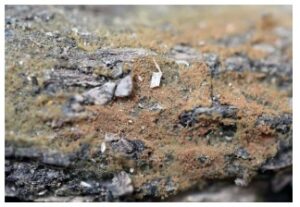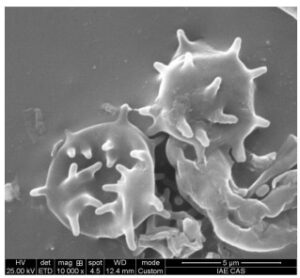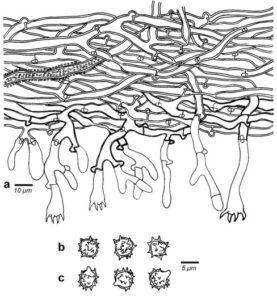Tomentella farinosa H.S. Yuan & Y.C. Dai, sp. nov.
Index Fungorum number: IF 555696; MycoBank number: MB 555695; Facesoffungi number: FoF 05618; Figs. 1, 2, 3
Etymology – Refers to the farinose hymenophore.
Holotype – IFP 019273.
Basidiocarps annual, resupinate, separable from the substrate, arachnoid, without odour or taste when fresh, 0.3–0.5 mm thick, continuous. Hymenophoral surface smooth to farinose, pale brown to brown (6D7–6E8) and darker than subiculum when dry. Sterile margin often indeterminate, byssoid, paler than hymenophore, olive brown. Subiculum mostly olive brown (4E6–8). Rhizomorphs absent. Subicular hyphae monomitic; generative hyphae clamped, thick-walled, frequently branched, 5–10 μm diam, occasionally collapsed and encrusted, reddish yellow in KOH, cyanophilous, inamyloid. Subhymenial hyphae clamped, slightly thick- to distinctly thick-walled, frequently branched, 4–7 μm diam; hyphal cells more or less uniform, reddish yellow in KOH, cyanophilous, inamyloid. Cystidia absent. Basidia 30–70 μm long and 5–10 μm diam at apex, 3–5 μm at base, with a clamp connection at base, clavate, not stalked, sinuous, rarely with transverse septa, pale yellow in KOH, yellowish brown in distilled water, 4-sterigmate; sterigmata 3–6 μm long and 1–1.5 μm diam at base. Basidiospores thick-walled, (4.5–)5–6.9(–7.5)×(4.5–)4.7–6.3(–6.5) μm, L=5.84 μm, W=5.5 μm, Q=1.04–1.08 (n=60/2), irregularly subglobose or lobed in frontal and lateral views, aculeate to echinulate, pale yellow in KOH, reddish yellow in distilled water, cyanophilous, inamyloid; echinuli usually isolated, sometimes grouped in 2 or more, up to 1.2 μm long.
Material examined – CHINA, Liaoning Province, Huanren County, Laotudingzi Nature Reserve, on rotten angiosperm branch, 21 October 2015, Yuan 10666 (IFP 019273, holotype); on rotten angiosperm wood debris, 21 October 2015, Yuan 10656 (IFP 019274); on rotten angiosperm trunk, 20
October 2015, Yuan 10655 & 10660.
GenBank numbers – ITS: KY686250, KY686251.
Notes – Tomentella brunneorufa M.J. Larsen is similar to T. farinosa by having continuous, arachnoid basidiocarps separable from the substrate, a byssoid sterile margin and basidiospores of approximately the same size. However, it is differentiated by the fulvous basidiocarps, the presence of
rhizomorphs and globose basidiospores (Larsen 1974; Kõljalg 1996). T. capitata has characteristics similar to T. farinosa, such as brown, continous basidiocarps separable from the substrate, a farinose hymenophore surface, the presence of rhizomorphs, clamped, thick-walled subicular hyphae and approximately the same shape basidiospores. But it differs by having capitate cystidia and bigger basidiospores (7–9 μm, Yorou et al. 2007).

Figure 1 – A basidiocarp of Tomentella farinosa (IFP 019273, holotype)

Figure 2 – SEM of Tomentella farinosa (IFP 019273, holotype) (a Subicular hyphae. b–d Basidiospores)

Figure 3 – Microscopic structures of Tomentella farinosa (IFP 019273, holotype). a Section through a basidiocarp. b Basidiospores in frontal view. c Basidiospores in lateral view
